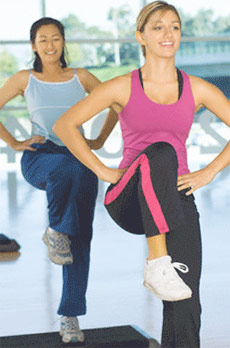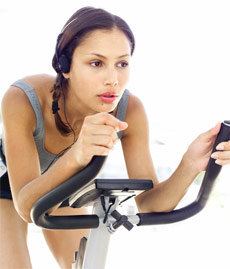

CardiovascularIntroductionThe word cardio for most bodybuilders strikes fear into the heart. Fear that the mere mention of the word will shrivel up their muscles so quick they will look like a concentration camp victim. Fear not, for cardio could be the key for unlocking potential growth. Cardiovascular exercise is one of the most important keys to getting that well defined, muscular physique. Similar to resistance training, there is science involved with cardio to heighten its results. The amount of body fat lost is in direct relation to the number of fat burning elements you zero in on. In other cases, cardio should be limited to once a week to ensure all possible calories are used to build as much muscle mass as possible. Timing of the day, intensity, duration, warming-up, stretching and cooling down are important components of effective cardiovascular training.
Article of the Week The Countdown For Rio Olympics BeginsJuly, 21 2016The 2016 Summer Olympics, commonly known as Rio 2016, is a major international multi-sport event due to take place in Rio de Janeiro, Brazil, from 5 to 21 August 2016. More> Related Article
Benefits of Cardio Training for BodybuildersWhen done correctly Cardio training offers a myriad of benefits to the women seeking gain in mass.Increased Capillary Network
Cardiovascular exercise is probably the quickest and easiest way to
increase the number of capillaries (small blood vessels) that
network throughout the muscles. These networks of capillaries bring
various nutrients and hormones to the muscle. Therefore the more
capillaries (described as a muscles capillary density) the more
nutrients that can be brought to a recovering muscle.
|
Age
|
MHR Per Minute |
60% of the MHR Per Minute |
65% of the MHR Per Minute |
70% of the MHR Per Minute |
75% of the MHR Per Minute |
80% of the MHR Per Minute |
85%of the MHR Per Minute |
20 |
200 |
120 |
130 |
140 |
150 |
160 |
170 |
25 |
195 |
117 |
127 |
137 |
146 |
156 |
166 |
30 |
190 |
114 |
124 |
133 |
143 |
152 |
162 |
35 |
185 |
111 |
120 |
130 |
139 |
148 |
157 |
40 |
180 |
108 |
117 |
126 |
135 |
144 |
153 |
45 |
175 |
105 |
114 |
123 |
131 |
140 |
149 |
50 |
170 |
102 |
111 |
119 |
128 |
136 |
145 |
55 |
165 |
99 |
107 |
116 |
124 |
132 |
140 |
60 |
160 |
96 |
104 |
112 |
120 |
128 |
136 |
65 |
155 |
93 |
101 |
109 |
116 |
124 |
132 |
70 |
150 |
90 |
98 |
105 |
113 |
120 |
128 |
Healthy Heart Zone
The first zone is called
the Healthy Heart Zone. This is 50-60% of your max HR. This is the
easiest and most comfortable zone within which to train and is the
one that is best for women who are just starting an exercise program
or have low functional capacity. Those of you who are walkers most
likely train at this zone. Although this zone has been criticized
for not burning enough total calories, and for not being intense
enough to get great cardio respiratory benefits, it has been shown
to help decrease body fat, blood pressure and cholesterol. It also
decrease the risk of degenerative disease and has a low risk of
injury. In this zone, 70% of carbohydrates are "burned" (use as
energy), 5% of protein is burned and whopping 85% of fat is burned.
Fitness Zone
The next zone is the Fitness Zone, which is 60-70% of your max HR.
Once again 85% of your calories burned in this zone are fats, 5% are
proteins and 10% are carbohydrates. Studies have shown that in this
zone you can condition your fat mobilization (getting fat out of
your cells) while conditioning your fat transportation (getting fat
to muscles). Thus, in this zone, you are training your fat cells to
increase the rate of fat release and training your muscles to burn
fat. Therefore, the benefits of this zone are not only the same as
the healthy heart zone training at 50-60% but you are now slightly
increasing the total number of calories burned and provide a little
more cardio respiratory benefits. You burn more total calories at
this zone simply because it is more intense.
Aerobic Zone
 The
third zone, the Aerobic Zone, requires that you train at 70-80% of
your max HR. This is the preferred zone if you are training for an
endurance event. In this zone, your functional capacity will greatly
improve and you can expect to increase the number and size of blood
vessels, increase vital capacity and respiratory rate and achieve
increases in pulmonary ventilation, as well as increases in arterial
venous oxygen. Moreover, stroke volume (amount of blood pumped per
heart beat) will increase, and your resting heart rate will
decrease. What does all this mean ? It means that your
cardiovascular and respiratory system will improve and you will
increase the size and strength of your heart. In this zone, 50% of
calories burned are from carbohydrates, 50% are from fat and less
than 1% is from protein. And, because there is in increase in
intensity, there is also an increase in the total number of calories
burned.
The
third zone, the Aerobic Zone, requires that you train at 70-80% of
your max HR. This is the preferred zone if you are training for an
endurance event. In this zone, your functional capacity will greatly
improve and you can expect to increase the number and size of blood
vessels, increase vital capacity and respiratory rate and achieve
increases in pulmonary ventilation, as well as increases in arterial
venous oxygen. Moreover, stroke volume (amount of blood pumped per
heart beat) will increase, and your resting heart rate will
decrease. What does all this mean ? It means that your
cardiovascular and respiratory system will improve and you will
increase the size and strength of your heart. In this zone, 50% of
calories burned are from carbohydrates, 50% are from fat and less
than 1% is from protein. And, because there is in increase in
intensity, there is also an increase in the total number of calories
burned.
Anaerobic
Zone
The next training zone is called the Threshold or Anaerobic zone,
which is 80-90% of your max HR. Benefits include an improved VO2
maximum (the highest amount of oxygen one can consume during
exercise) and thus an improved cardio respiratory system, and a
higher lactate tolerance ability which means your endurance will
improve and you'll be able to fight fatigue better. Since the
intensity is high, more calories will be burned than within the
other three zones. Although more calories are burned in this zone,
85% of the calories burned are from carbohydrates, 15% from fat and
less than 1% are from protein.
Red-Line Zone
 The
last training zone is called the Redline Zone, which is 90-100% of
your max HR. Remember, training at 100% is your maximum heart rate
(maximum HR), your heart rate will not get any higher. This zone
burns the highest total number of calories and the lowest percentage
of fat calories. Ninety percent of the calories burned here are
carbohydrates, only 10% are fats and again less than one percent is
protein. This zone is so intense that very few women can actually
stay in this zone for the minimum 20 minutes, or even five minutes
(you should only train in this zone if you are in very good shape
and have been cleared by a physician to do so). Usually, women use
this zone for interval training. For example, one might do three
minutes in the Aerobic Zone and then one minute in this Red-line
Zone and then back to the Aerobic Zone (this is called interval
training and will be discussed further in a future article).
The
last training zone is called the Redline Zone, which is 90-100% of
your max HR. Remember, training at 100% is your maximum heart rate
(maximum HR), your heart rate will not get any higher. This zone
burns the highest total number of calories and the lowest percentage
of fat calories. Ninety percent of the calories burned here are
carbohydrates, only 10% are fats and again less than one percent is
protein. This zone is so intense that very few women can actually
stay in this zone for the minimum 20 minutes, or even five minutes
(you should only train in this zone if you are in very good shape
and have been cleared by a physician to do so). Usually, women use
this zone for interval training. For example, one might do three
minutes in the Aerobic Zone and then one minute in this Red-line
Zone and then back to the Aerobic Zone (this is called interval
training and will be discussed further in a future article).
When you begin achieving great results, the excitement and fun you
experience will make the change well worth the effort. Action
creates motivation.
Top
Helpline
Track Your Progress
- Basal Metabolic Rate
- Protein Calculator
- Target Weight
- Waist to hip ratio (WHR)
- Body Mass Index
- Rate Your Flexibility
- Pregnancy Due Date
- FAQ
-
Ask a
Question

-
Share






